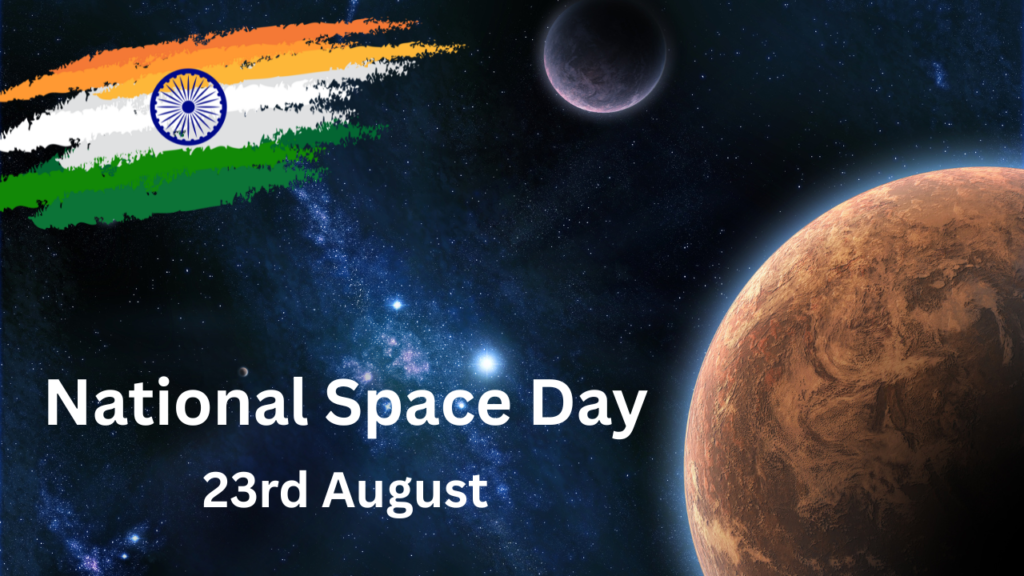National Space Day Celebrated In India

On 23rd August 2025, India celebrates its 2nd National Space Day. India successfully landed Chandrayaan-3 on the South Pole of the Moon by ISRO on August 23, 2023. India is the only country to land successfully on the South Pole of the moon.
The place where Chandrayaan-3 landed was named the “Shiv Shakti point” by our Prime Minister, Narendra Modi. This year’s theme, “Aryabhatta to Gaganyaan: Ancient Wisdom to Infinite Possibilities,” links India’s rich astronomical legacy with its modern-day space ambitions. It reminds us that our journey is both civilizational and futuristic, rooted in heritage yet rising to embrace the boundless horizons.
India is rich in terms of astronomy and space research. India is no less than any other advanced country.
Paving the way for realizing the Indian space station and crude Lunar Mission and writing a new chapter of human presence in space, Group Captain Shubhanshu Shukla became the first Indian captain to visit the International Space Station, completing the axiom formation with 60 experiments and 20 outreach events. 23rd August remains an edge forever in India’s golden history.
The day Chandrayan 3 touched down on moon’s hemisphere. It was not just a technological triumph, it was an emotional milestone engraved into the heart of every Indian when Prime Minister Narendra Modi declared it as National Space Day.
This day is not merely a celebration; it is a reaffirmation of resolve to strengthen our commitment and to chart the future of India at the frontiers of space. The theme of National Space Day encapsulates the spirit of Aryabhatta to Gaganyan to ancient wisdom to infinite possibilities. It reminds us that our journey is both civilizational and futuristic, rooted in heritage yet rising to embrace the boundless horizons.
As we celebrate, we also recommit ourselves to touching not just the moon and beyond but touching lives here on Earth, the power, promise, and purpose of India’s space journey.
A journey that got strength from our ancient wisdom by opening doors to infinite possibilities.
23rd August 2023 was a historical day. India successfully landed Chandrayan 3 on the South Pole of the Moon. We are the only country to land successfully on the South Pole of the Moon. Narendra Modi gave a speech on the National Space Day and highlighted its theme, from Aryabhat to Gaganyan. He said that in the Indian space journey we have the confidence of the past and the determination of the future.
India’s Space Missions:-
- The Aryabhata satellite was the first Indian satellite to be launched in 1975.
- In 1983 Indian National Satellite Series was launched, which brought a revolution in the telecommunications sector in India.
- Then the GSAT series was constructed.
- On 22nd October, 2008 Chandrayan 1 was launched into the space which turned to be India’s first mission to the moon.
- In 2014, the Mars Orbiter mission, popularly known as MOM, made India the first nation to reach Mars.
- Chandrayaan 3 made it possible to land on the South Pole of the moon.
Frequently Asked Questions
1. What is National Space Day in India?
On 23rd August, we celebrate the National Space Day in India. On this day successful deployment of the Pragyaan Rover took place on the moon.
2. What is the theme of National Space Day 2025?
The theme is: “Aryabhatta to Gaganyaan : Ancient Wisdom to Infinite Possibilities”.
3. Is there an International Space Day?
There isn’t an officially recognized “International Space Day” by the United Nations. However, Space Day is celebrated in the U.S. on the first Friday of May each year. It was started in 1997 by Lockheed Martin and later expanded with NASA’s involvement to encourage interest in space and STEM.
Also Read:-
- August 15 2025 Independence Day Speech
- Debate on One National Language : 5 Insightful Points For and Against
- Exploring the Controversial Debate on Social Media Vetting in Today’s Digital Age: 4 Points
- 100 Powerful Examples of Future Continuous Tense and Structure
- National Education Policy 2025: The Great Debate—Points For and Against

Written by Sukhjit Kaur, English educator with 17+ years of experience helping students master grammar and writing. Through EnglishVedas.com, she simplifies English grammar using examples from daily life and classrooms.
